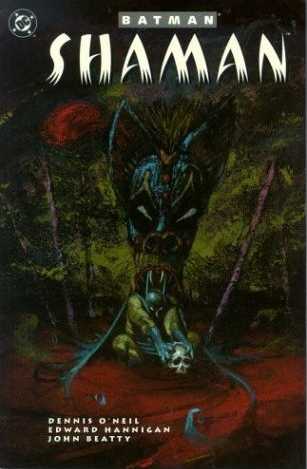Home |
Contents |
Photos |
News |
Reviews |
Store |
Forum |
ICI |
Educators |
Fans |
Contests |
Help |
FAQ |
Info


Sham of a SHAMAN
(9/24/06)

Just read BATMAN: SHAMAN, the first story arc in the comic LEGENDS OF THE DARK KNIGHT, which debuted in 1989. A reviewer on Amazon.com summarizes the storyline:
This story begins just a few weeks before Miller's Batman: Year One. The two stories begin as a linked entity, the split into separate directions.
As a young Bruce Wayne that is not yet Batman tracks a killer in Alaska, he is nearly killed himself. Brought back to life by an Alaskan Shaman with a story of the Bat, Bruce is saved. He returns to his native Gotham to find the town plagued by a mysterious serial killer, taking lives in the name of Chubala, a religion of the Caribbean.
To complicate things further, a museum is broken into a several relics of the tribe that saved Bruce Wayne are stolen. People linked with the tribe are dying, being murdered by some mysterious foe that wears the mask of the bat.
A newly created Batman must learn what the Legend of the Bat from Alaska has to do with an African religion and a glut of murder and drugs in Gotham.
For a more detailed review, see The Comics Get Serious.
From the Native perspective, this story has a lot of problems. These include:
The Native people are referred to as "Indians of Northern Alaska." They live "not far from the Arctic Circle." But the only Native people in that location are Inuit, not Indians.
The old Native who tells Wayne a healing story is variously referred to as a "shaman" and a "medicine man." They aren't the same thing and there's no evidence the old man is a shaman rather than a medicine man.
His granddaughter is a stereotypical black-haired beauty with Westernized features.
The healing story involves Raven giving Bat wings to blow away the "ghost disease." I suppose there are bats in the vicinity of the Arctic Circle, but I question whether the Natives would have a major story about them.
The healing story is drawn in the style of a typical Raven story of a Pacific Northwest tribe. A bat mask looks and operates like a typical mask of a Pacific Northwest tribe. The Natives' village has the typical totem poles of a Pacific Northwest tribe. Only problem is that Pacific Northwest tribes live in southeastern Alaska, along the coast, not in northern Alaska near the Arctic Circle.
Bruce Wayne tells the story he was never supposed to reveal to an anthropologist. This isn't a cultural mistake, but it's not in keeping with Wayne's character. Generally he would honor people's requests even if he didn't believe in their validity.
A man steals the tribe's artifacts—the bat mask and a bow and arrows—and uses them to commit crimes. But the Inuit didn't use bows and arrows because of the lack of wood that far north.
Wayne returns to the northern village to find the old man acting like a clown—doing his "sacred dance" for tourists. Supposedly he feels shame because the anthropologist tricked him into revealing the tribe's sacred stories. I don't know for sure, but I doubt this kind of public atonement is part of the Inuit or Pacific Northwest cultures.
The granddaughter reveals that the anthropologist has corrupted the village by bringing it "all the glittering junk of what you call civilization." That includes liquor and drugs. If this story takes place 10 years before the present and it was published in 1990, the time frame for this corruption would be around 1980.
While it's possible that one anthropologist could corrupt a formerly pristine village in 1980, it's doubtful. Most Alaskan villages probably adopted the white man's ways in the mid-20th century, after WW II. And they were probably influenced more by the military and the oil companies than by lone anthropologists.
The woman is injured and the old man has Wayne tell her the healing story while wearing his own "bat mask." It apparently works. The idea that anyone can perform a Native medicine ceremony just by adopting its trappings is probably anathema to most tribes. It trivializes the extensive training and knowledge needed to conduct such a ceremony.
The old man elaborates on his healing story, saying Bat blew the sickness "into the nest of the vulture. Vulture went away forever." I feel confident that there aren't any vultures near the Arctic Circle and never were. The Inuit (or "Indians of northern Alaska") wouldn't tell stories about them—even to explain why they're no longer around.
It becomes clear that the man who's pretending to a "Chubalan shaman" (akin to a Santeria priest or a voodoo practitioner) is the aforementioned vulture. He has taken control of the Caribbean drug trade and "adopted the guise of what those dealers and runners fear most, a Chubalan shaman." In this identity, he performs human sacrifices, because that's what Chubalans supposedly do.
Ignore for a moment that the storyline juxtaposes the two "primitive" religions. That it repeatedly asserts that they're linked somehow. That it calls both religious practitioners "shamans" as if they're equivalent. That the Chubalan shaman, with his painted face and skull, doesn't look much different from a tribal priest.
The storyline links the two religions explicitly through the Bat story. Vulture, the castoff from the Alaskan mythology, goes on to found a religion based on human sacrifice. While this isn't quite the same as saying Natives condoned such sacrifices, it isn't entirely different, either.
In summary, I'd say BATMAN: SHAMAN is a standard Batman story. The Native aspects, especially the idea that the Natives influenced Wayne to "become the Bat," are mildly interesting. But the story is badly flawed in terms of Native cultures. Native youths, schools, and libraries probably should give it a pass.
Related links
Shamans, medicine men, or priests?
Comic books featuring Indians
* More opinions *
|
|
. . .
|

|
Home |
Contents |
Photos |
News |
Reviews |
Store |
Forum |
ICI |
Educators |
Fans |
Contests |
Help |
FAQ |
Info
All material © copyright its original owners, except where noted.
Original text and pictures © copyright 2007 by Robert Schmidt.
Copyrighted material is posted under the Fair Use provision of the Copyright Act,
which allows copying for nonprofit educational uses including criticism and commentary.
Comments sent to the publisher become the property of Blue Corn Comics
and may be used in other postings without permission.


